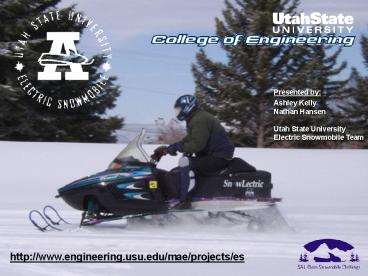Electric Snowmobile Utah State University - PowerPoint PPT Presentation
Title:
Electric Snowmobile Utah State University
Description:
Top row, left to right: Nathan Hansen (team leader) ... Scott Duhadway, Rob Silver, Paul Carpenter ... Towing hitch. Comfortable seat. Stow compartments in seat ... – PowerPoint PPT presentation
Number of Views:50
Avg rating:3.0/5.0
Title: Electric Snowmobile Utah State University
1
Presented by Ashley Kelly Nathan Hansen Utah
State University Electric Snowmobile Team
http//www.engineering.usu.edu/mae/projects/es
2
Overview
- Team Structure and Organization
- Objectives
- Comparison to Stock
- Testing and Energy Models
- Modifications
- Results
- Features of Final Product
- Future Work and Conclusion
3
Our Team
Top row, left to right Nathan Hansen (team
leader), Denton Johnson, Byard Wood (faculty
advisor), Scott Duhadway, Rob Silver, Paul
Carpenter Front row, left to right Nathaniel
Hollingsworth, Ashley Kelly, Jed Jenkins, Merin
Swasey, Steven Hanson, Ira Tibbits (Not
pictured Justin Maughan)
4
USU Electric Snowmobile Team Organization
5
(No Transcript)
6
Specifications
Stock
Modified Electric
7
Video Comparison of Stock vs. Electric Conversion
(1997 Polaris Indy Trail 500)
8
Dyno Testing the Motor
9
Field Testing to Find Energy Requirements
It was desired to know the energy requirement of
the snowmobile at various velocities. This was
accomplished by drag testing and gathering
force vs. velocity data.
10
Modeling and Testing
Energy models were built based on testing results
and theoretical analysis. These were built using
Mathsoft Mathcad, Microsoft Excel, and Intel
FORTRAN 90/95 software. The use of this software
made perturbation of possible solutions simple,
and helped uncover the full scale effect of
changing variables.
Example of how energy models were used Selection
of drive train gear ratio, based on energy
requirements of the snowmobile, discharge
characteristics of the battery, and motor
performance. Decisions were made towards meeting
competition requirements.
11
Motor Testing Series vs. Parallel
The electric motor was rewired so that half of
the four field coils could be run in parallel.
This was done to reduce the amount of current
that would be required at cruising speeds. The
discharge rate of the batteries is the largest
factor in electric snowmobile range, and any
decrease in discharge rate leads to a logarithmic
increase in range.
12
Testing Progression
13
Modifications
Many of the stock components in the snowmobile
had to be redesigned to accommodate the
requirements of electric vehicle parts. Possible
designs were analyzed for performance and
integrity. For example, the electric motor mount
was rebuilt
Original electric motor mount Yielded
excessively under motor load
Current electric motor mount More appropriate
to performance of motor
14
Suspension
Modification was required in the rear suspension
to handle additional loading from the batteries,
and also to improve performance. The
new suspension gives twice as much rear travel as
the stock design did when loaded with batteries.
Rider Comfort also increased.
15
User Friendly
- Batteries charge off of 120 V AC household
current - Charge time approximately 3.5 hours
- Easy quick disconnect to isolate high voltage
system - Drive and control just like a normal snowmobile
- Reverse
- Towing hitch
- Comfortable seat
- Stow compartments in seat
- Simple dash gauges to indicate speed, distance,
current, - voltage, and motor speed
16
Towing Capability and Utility
SnoWatt towing a 1995 Jeep Grand Cherokee (4345
lbs)
17
Replaceable, Durable, and Low Cost
- Aftermarket parts are COTS (Commercial Off The
Shelf) technology - Motor Advanced DC 203-06-4001
- Controller Curtis 1221-C
- Throttle Curtis PB-6 Potbox
- Contactor Kilovac Czonka
- Batteries Universal Power UB12550 VRLA AGM
- Drive Train Gates Polychain GT HTD
- All major parts engineered to provide an
additional safety - factor in endurance and performance
- Parts are readily available from a variety of
suppliers - Charging system is plug and play, using a
standard power outlet - All other components remain stock
- Cost
- TICA Cost of 2208.25 for fully electric
conversion
18
Safety
Anderson style disconnect for high voltage
Additional guards for mechanical components
Warning lights to indicate connected high voltage
High voltage contactor
- Not Pictured
- Sealed, vented, and secured battery box
- In-line fuses in all electrical systems
- All major components are hermetically sealed
- Handle bar and tether kill switch
- Inertial kill switch (removed
- for performance handling)
19
Performance
- Improvements
- Zero on-site Emissions
- Substantial Reduction in Noise (no motor or
clutch noise) - Good Acceleration (0-500 feet in 10.9 seconds)
- Excellent Utility Performance
- Compromises
- Range (9-12 miles)
- Weight (nearly 300 pounds heavier)
- Top Speed (reduced to 35 mph in direct drive
system) - Range and weight could be massively improved just
by - dropping in a different battery technology.
20
Future Work
Much of efforts this year have been to establish
a foundation that future teams may build on.
Plans for next years CSC snowmobile include
- Weight Reduction!
- Reduction in energy requirements
- Friction in track
- Drive Train losses
- Noise reduction in mechanical components (track,
chain) - Improvements in battery technology
- Improvements in suspension and handling
21
Conclusion
- Our strength is in simple design and solid
engineering choices - Unique electric approach is a quiet, clean, and
practical solution - Possible Markets
- Scientists
- National Parks and Recreation Areas
- Utility Users (snowmobile equivalent of heavy
duty truck) - Environmentally conscientious snowmobilers
- Short range commuting
- The involvement of the National Science
Foundation (summer 2006) - and Yellowstone National Park lend great
credibility and further - the possibility of long term research into
this exciting new - technology.































